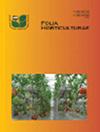The influence of different methods of under-vine management on the structure of vegetation and the qualitative parameters of the grapes in the Moravian wine region
IF 1.8
4区 农林科学
Q2 HORTICULTURE
引用次数: 0
Abstract
The present article explores the importance of vineyard soil management. Studies on under-vine management have yielded a wide range of results, with some indicating potential benefits for vine growth and productivity. However, the methods of under-vine management and their specific effects on vineyard parameters require further research. The aim of this study is to evaluate the relationships existing between the different types of management of under-vine areas and the vegetation grown in this zone and to determine the effects of under-vine management on the yield and quality of Traminer grapevines. By examining various approaches, the research aims to provide insights into the optimising of vineyard management methods to achieve enhanced biodiversity and grape quality in this specific geographical context. The findings indicated that management of the under-vine area can impact the composition of plants, grape yield and quality. Under-row management had an effect on the number of plant species and their composition. The highest weight of bunches was found in MIX (a species from the Fabaceae family), while the lowest was found in the MECH treatment (bare soil). MULCH, MONO and MIX consistently had higher yeast assimilable nitrogen (YAN) in grapes than other treatments. In many of the evaluated parameters, the influence of the seasons was evident.不同的葡萄树下管理方法对摩拉维亚葡萄酒产区植被结构和葡萄质量参数的影响
本文探讨了葡萄园土壤管理的重要性。关于葡萄树下管理的研究取得了广泛的成果,其中一些成果显示了葡萄树生长和生产力的潜在益处。然而,葡萄树下管理的方法及其对葡萄园参数的具体影响还需要进一步研究。本研究旨在评估不同类型的葡萄树下管理与该区域种植的植被之间的关系,并确定葡萄树下管理对特拉米纳葡萄产量和质量的影响。通过研究各种方法,该研究旨在为优化葡萄园管理方法提供见解,从而在这一特定的地理环境中提高生物多样性和葡萄质量。研究结果表明,葡萄树下区域的管理会影响植物的组成、葡萄的产量和质量。行下管理对植物种类的数量及其组成有影响。MIX(一种豆科植物)的葡萄串重量最高,而 MECH 处理(裸土)的葡萄串重量最低。MULCH、MONO 和 MIX 处理的葡萄酵母同化氮(YAN)始终高于其他处理。在许多评估参数中,季节的影响都很明显。
本文章由计算机程序翻译,如有差异,请以英文原文为准。
求助全文
约1分钟内获得全文
求助全文
来源期刊

Folia Horticulturae
Agricultural and Biological Sciences-Horticulture
CiteScore
3.40
自引率
0.00%
发文量
13
审稿时长
16 weeks
期刊介绍:
Folia Horticulturae is an international, scientific journal published in English. It covers a broad research spectrum of aspects related to horticultural science that are of interest to a wide scientific community and have an impact on progress in both basic and applied research carried out with the use of horticultural crops and their products. The journal’s aim is to disseminate recent findings and serve as a forum for presenting views as well as for discussing important problems and prospects of modern horticulture, particularly in relation to sustainable production of high yield and quality of horticultural products, including their impact on human health.
 求助内容:
求助内容: 应助结果提醒方式:
应助结果提醒方式:


